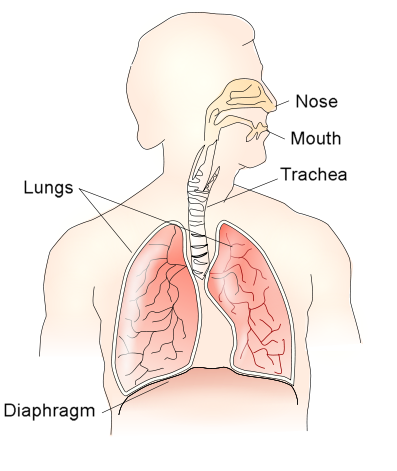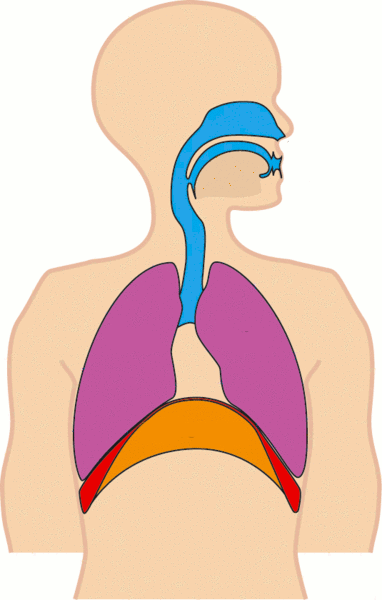Respirer Somatiques Cliniques des exercices
Many students ask me how to breathe correctly when practicing Clinical Somatics exercises. Your breathing pattern is more important in some exercises than others, depending on whether or not the exercise includes extension (arching) or flexion (curling) of the spine.
In this article I’ll describe why diaphragmatic breathing is important, the general principle of how to breathe when practicing Clinical Somatics exercises, and some step-by-step examples of how to breathe in specific exercises. The bottom line is that you should breathe as much as you need to and never hold your breath; but, learning how to breathe in the following ways will allow you to get the most benefit from your Clinical Somatics practice.
If you find that you have trouble taking deep breaths and allowing your belly to expand, please read How to Relieve Shallow Breathing.
Why we practice diaphragmatic breathing in Clinical Somatics exercises
As you can see in the diagrams below, the diaphragm is an umbrella-shaped muscle located just below our lungs. In diaphragmatic breathing, we contract our diaphragm, pulling its center downward and inverting its umbrella shape as we inhale. This action draws air into our lungs, and pushes the contents of our belly forward. So, our abdominal muscles must be able to fully relax in order to allow us to take a full inhale and let our belly expand forward. Then as we release our diaphragm, it relaxes upward and expels the air out of our lungs.


A form of diaphragmatic breathing occurs naturally and automatically in all mammals when they are in a state of relaxation. This type of breathing is known as eupnea and requires no conscious effort. In the state of eupnea, the diaphragm and external intercostal muscles automatically contract to draw air into the lungs. The abdominal muscles are relaxed, allowing the belly to gently expand forward during inhalation. The chest also expands during inhalation, and the collarbone and shoulders will subtly rise. During exhalation, the belly, chest, collarbone and shoulders all return to their neutral resting position.
When we become stressed for any reason, however, we instinctively shift to shallow breathing. This type of breathing involves drawing air into the lungs using the intercostal muscles (the muscles in between the ribs) instead of the diaphragm. As a result, in shallow breathing the chest expands instead of the belly.
The most common physiological issue associated with shallow breathing is a heightened level of stress due to constant activation of the stress response. Stress causes us to breathe shallowly, and if we experience stress on a regular basis, our shallow breathing becomes habitual. We continue to breathe shallowly whether or not we’re experiencing stress, and the shallow breathing itself actually activates our stress response.
La respiration superficielle est également associée à des troubles anxieux, des attaques de panique, une hyperventilation, un choc, de l'asthme, une pneumonie, un œdème pulmonaire et une accumulation de dioxyde de carbone dans le corps appelée hypercapnie.
Since habitual shallow breathing triggers our stress response—which includes increasing our muscle tension—we want to make sure we’re breathing diaphragmatically while we practice Clinical Somatics exercises. If you find that you have trouble taking slow, deep breaths and allowing your belly to expand, please be sure to read How to Relieve Shallow Breathing.
Courbure et aplatissement : prolongements naturels de l'inspiration et de l'expiration
So, the first guideline to breathing in Clinical Somatics exercises is that you should always try to breathe diaphragmatically. The exercises will be most effective if you are completely relaxed and not holding your breath.
The second guideline is that you should inhale as you do any sort of Arch or extension of your spine, and exhale as you Flatten, Curl, or do any sort of flexion of your spine.
Voici pourquoi : L'extension et la flexion de la colonne vertébrale sont des extensions naturelles des mouvements d'inspiration et d'expiration.
When you inhale, your diaphragm moves downward and your belly expands. If you are relaxed, you should feel a gentle, natural extension or arching of your spine as you inhale. When you want to take a really deep inhale, you may notice that you actively arch your back to create more space in your chest and abdomen.
When you exhale, your lungs empty and your belly returns to normal. If you want to expel the air from your lungs more completely or forcefully, you can contract your abdominals and internal intercostals to reduce the space in your abdomen and chest.
Si vous essayez de faire le contraire – inspirez en vous aplatissant ou en vous courbant, ou expirez en faisant une cambrure – vous constaterez que cela vous semble difficile et anormal.
How to breathe in specific Clinical Somatics exercises
Commençons par le Arche et Aplatir:
- 1. L'arc: Inspirez dans votre ventre pendant que vous roulez votre bassin vers l'avant, en cambrant le bas du dos.
- 2. Expirez et respirez au besoin en relâchant très lentement les muscles du bas du dos pour revenir au neutre. Si vous vous déplacez très lentement, vous devrez peut-être prendre plusieurs respirations lorsque vous reviendrez au point mort. Veuillez noter : il ne s'agit pas de l'aplatissement ; cette partie est simplement la sortie de l'Arche.
- 3. Pendant que vous vous reposez au point mort, inspirez dans votre ventre.
- 4. L'aplatir : Expirez en aplatissant le bas du dos vers le sol.
- 5. Respirez comme vous en avez besoin lorsque vous relâchez l'aplatissement. Si vous vous déplacez très lentement, vous devrez peut-être prendre plusieurs respirations pour revenir au point mort.
Vous pouvez suivre ce modèle pour le Arche et Courbe, unilatéral Arche et Courbe, Diagonale Arche et Courbe, Floraison Arche et Courbe, et Courbe Diagonale.
Le même schéma s'applique aux Courbe Latérale:
- 1. Inspirez pendant que vous vous reposez au neutre.
- 2. La boucle : Expirez en vous recroquevillant sur le côté.
- 3. Respirez comme vous en avez besoin pendant que vous relâchez pour redescendre au neutre. Si vous vous déplacez lentement, vous devrez peut-être prendre plusieurs respirations pendant que vous relâchez.
Dans le Soulever le Dos, j'instruis que vous devez inspirer pendant les extensions du dos : le soulèvement de la tête, le soulèvement de la tête et du bras, et le mouvement complet. Vous pouvez également inspirer en levant la jambe. En dehors de ces inspirations, respirez simplement selon vos besoins. Vous devrez probablement prendre plusieurs respirations lorsque vous relâchez les extensions du dos.
Lecture recommandée:
Le secret du soulagement de la douleur : comment recycler votre système nerveux, soigner votre corps et surmonter la douleur chronique par Sarah Warren, CSE
Somatique : réveiller le contrôle mental du mouvement, de la flexibilité et de la santé par Thomas Hanna

